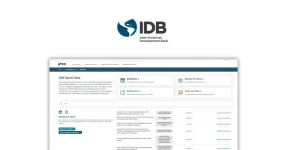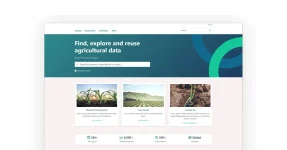This blog post was co-authored by Sergey Motornyuk, Senior Solutions Architect at Link Digital.
As a global company focused on supporting open data, digital service design and citizen centred design practices, Link Digital utilises a variety of open source software. The key one, which we talk about a lot, is CKAN. Another vital tool that we don’t talk so much about is a powerful open source content management system called Drupal. Indeed, we often use CKAN and Drupal together in applications that involve managing and publishing data.
While CKAN can be configured and set up to function as a data catalogue or open data platform once it is deployed and hosted on a web server, Drupal is deployed to help manage and present large data repositories in an attractive, interactive and user-friendly way. The following post will examine Drupal’s capabilities, including its synergies with CKAN, why organisations choose Drupal for their content management, and how Link Digital has made it work for our clients.
Exploring Drupal’s functionality
Drupal is used to build websites and other web applications. It helps web developers establish ways for humans to better interact and experience data on the web, by allowing users to create, manage and organise content, including text, images, and videos, in different formats, such as web pages, blogs posts, articles, forums, and research spaces.
Drupal has a functionality that can be utilised for small blogs and very basic open data portals. But where the software really comes into its own is in the building of high-traffic, enterprise-level platforms of the type needed by governments, multilateral organisations and large not-for-profits and research organisations. Its powerful features include:
- A permission management system that allows users to define and set roles to a very granular level. This includes establishing detailed permissions regarding who can upload, edit and view data, including multi-stage content approval.
- Tools to create efficient workflow processes, including content creation, publishing and moderation. This enables collaborative content development while ensuring published material meets any necessary internal standards.
- A high degree of scalability. Drupal offers a core system, but this functionality can be extended through a variety of modules or plugins.
- Built in support for creating multilingual websites and allowing users to upload and publish content in multiple languages.
- Easy integration with external systems, marketing automation tools, and social media platforms, that can allow organisations to seamlessly manage data across their various platforms.
- A large, active open source community that continually monitors the software and contributes to its development. Users can take advantage of this to access regular updates, new modules, and security patches, while avoiding being locked into proprietary contracts.
Using Drupal and CKAN together
Drupal functions well with CKAN. Drupal’s high-level user interface (UI) capabilities mean that it often serves as the front-facing user management system of a data catalogue or open data portal, while CKAN manages the backend. Users can utilise Drupal’s flexible theming and content management structure to enable users to create a visually engaging web application. This enhances the presentation of the data and creates a far more interactive, content-rich and attractive web user experience.
Drupal can incorporate CKAN datasets seamlessly into other content such as blogs, articles, and tutorials. CKAN datasets can be integrated with Drupal’s extensive user permission settings to control access to datasets. As part of this, CKAN can leverage Drupal’s authentication mechanisms to allow single sign-on or role-based access.
While CKAN and Drupal work well together they remain two separate pieces of software, even when they are utilised ‘under the hood’, so speak, in the same data project. As a result, while it is possible to share data between the two pieces of software, it requires a lot of hard work on the part of developers behind the scenes to make it happen efficiently. To cite one small example, when a user comes from a Drupal page to a CKAN page, the former must remain logged in as it tries to deal with CKAN.
To bridge these issues, Link Digital recently developed a CKAN Sync for Drupal module that can be added for configuration in a plug-and-play manner with any Drupal project. This allows developers to connect their Drupal site menu structure of any CKAN enabled open data management system via what is known as a RESTful API (the interface that two computer systems utilise to request and send information over the Internet in a secure manner). This is an opportunity to combine the native interoperability already present in both projects in a more meaningful way.
Link Digital’s work with Drupal
Link Digital has extensive Drupal experience. Its developers use the software to design unique and visually appealing designs for web applications. This can include customising data catalogues and open data portals to match the client’s unique branding. We also use it to create permission settings for data stewards and content managers and utilise Drupal’s extensive extensions and plugins to extend the software’s functionality and meet client needs, including when they may want to integrate their data and digital operations with third party systems.
We often use Drupal is often used as a ‘cover’ for CKAN. For example, when an external user lands on an open data portal, it is interacting with the Drupal part of the application. It logs into Drupal and Drupal decides whether the user has permission to go into CKAN and what exactly it can do inside once, such as view or download datasets. These datasets will be managed by the CKAN software, but the dashboards and charts that the user will be viewing data in are created and managed by the Drupal part of the application.
Link Digital’s Drupal work has included:
Canadian Watershed Information Network
Managed by the University of Manitoba’s Centre for Earth Observation Science, the CanWIN site is an internal data management platform that collects and manages a large array of climate data, including spatial data, and shares it with researchers. CanWIN uses Drupal to enable the site to have custom content types for datasets, project pages, research publications, etc, helping to make information storage as efficient as possible. Drupal enables users to search through the site’s datasets and content based on specific parameters like location, time, or category. And Drupal’s UI functionality provides strong visual theming and customisation, enhancing the user experience, and making data more accessible and visually appealing.
Pacific Data Hub
Launched in late 2020, the Pacific Data Hub (PDH) is overseen by the Pacific Community and serves as a gateway to the most comprehensive data collection of relevance to the 22 Pacific Island nations and territories. Drupal is core to the portal’s ability to visually illustrate data searches by country or sector. This allows the portal to not only present the most relevant datasets, but a selection of charts that try and visualise the data in an informative and attractive way.
Vehicle Emissions Star Rating
The Vehicle Emissions Star Rating (VESR) website was initiated by the New South Wales Government to assist consumers to factor in the environmental impact when planning their next vehicle purchase. It does this by using a simple star rating that enables them to compare the carbon dioxide tailpipe emissions of over 16,000 passenger vehicles. The development build was done using Drupal and enables data to be presented in a simple, easy to use, and visually appealing format, including enabling consumers to see a star rating and image for every vehicle on the site.
Let’s talk about your Drupal project
Does your organisation need help with a Drupal project? If so, contact us and tell us about your project.



